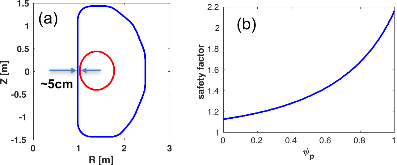MARS-F modeling of post-disruption runaway beam loss by magnetohydrodynamic instabilities in DIII-D
- General Atomics, San Diego, CA (United States)
- SLS2 Consulting, San Diego, CA (United States)
A drift orbit model for relativistic test electrons has been incorporated into the MARS-F code, in order to study the runaway electron (RE) behavior in the presence of magneto-hydrodynamic perturbations computed by MARS-F. By implementing the model directly into the MARS-F curve-linear magnetic coordinates, maximal accuracy in representing the full field perturbation is preserved. The updated code is utilized to study the high current RE beam loss in a post-disruption DIII-D plasma, revealing that a fast growing, n = 1 (n is the toroidal mode number) resistive kink instability, at ~100 Gauss level, can induce significant fraction of RE loss, largely by perturbing drift orbits of REs. A 103 Gauss perturbation fully terminates the RE beam, as found in both experiment and modeling. The 3-D field induced loss increases with the perturbation amplitude but decreases with the particle energy. The loss fraction is generally not sensitive to the initial particle pitch angle. The particle velocity change, due to electric field acceleration/deceleration, small pitch angle scattering, synchrotron radiation and Bremsstrahlung, further perturbs the RE trajectory but plays a minor role in prompt RE loss within microseconds time scale. Therefore, the dominant dependencies are simply the RE energy and instability strength. For comparison, a resonant magnetic perturbation field, generated by 4 kAt n = 3 even parity I-coil currents in DIII-D and with the plasma response field included, is found to induce almost no loss for the same RE beam.
- Research Organization:
- General Atomics, San Diego, CA (United States)
- Sponsoring Organization:
- USDOE Office of Science (SC), Fusion Energy Sciences (FES)
- Grant/Contract Number:
- FG02-95ER54309
- OSTI ID:
- 1568765
- Journal Information:
- Nuclear Fusion, Vol. 59, Issue 12; ISSN 0029-5515
- Publisher:
- IOP ScienceCopyright Statement
- Country of Publication:
- United States
- Language:
- English
Web of Science
Similar Records
Toroidal modeling of runaway electron loss due to 3-D fields in DIII-D and COMPASS
Passive deconfinement of runaway electrons using an in-vessel helical coil



















